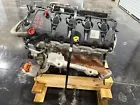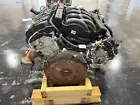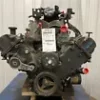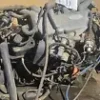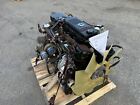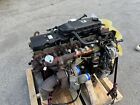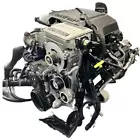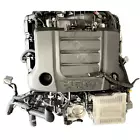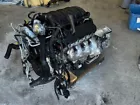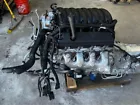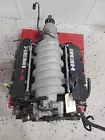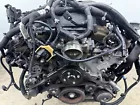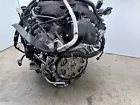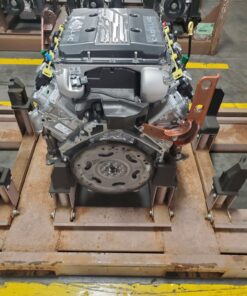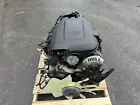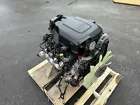FORD F150 5.0L COYOTE ENGINE
2,800 $ Original price was: 2,800 $.2,550 $Current price is: 2,550 $.
Ford F-150 5.0L Coyote V8 Engine: A Comprehensive Overview
The FORD F150 5.0L COYOTE ENGINE is one of the most iconic engines in Ford’s modern lineup, blending old-school American V8 muscle with cutting-edge engineering. First introduced in the 2011 Mustang GT, the Coyote V8 quickly found its way into the FORD F150 5.0L COYOTE ENGINE, offering Ford enthusiasts a powerful and reliable option amid an increasingly turbocharged world.
In the FORD F150 5.0L COYOTE ENGINE, the Coyote engine delivers the kind of performance and dependability that truck owners demand whether hauling loads, towing trailers, or simply enjoying the deep rumble of a naturally aspirated V8. This in-depth analysis will walk you through every facet of the Coyote V8 as it relates to the F-150 platform.
Ford F-150 5.0L Coyote V8 Engine: A Comprehensive Overview
The FORD F150 5.0L COYOTE ENGINE is one of the most iconic engines in Ford’s modern lineup, blending old-school American V8 muscle with cutting-edge engineering. First introduced in the 2011 Mustang GT, the Coyote V8 quickly found its way into the FORD F150 5.0L COYOTE ENGINE, offering Ford enthusiasts a powerful and reliable option amid an increasingly turbocharged world.
In the FORD F150 5.0L COYOTE ENGINE, the Coyote engine delivers the kind of performance and dependability that truck owners demand whether hauling loads, towing trailers, or simply enjoying the deep rumble of a naturally aspirated V8. This in-depth analysis will walk you through every facet of the Coyote V8 as it relates to the F-150 platform.
Development Background FORD F150 5.0L COYOTE ENGINE
Ford designed the FORD F150 5.0L COYOTE ENGINE as part of the Modular Engine Family, originally intended to replace the aging 4.6L and 5.4L V8s. It needed to meet several key goals:
-
Surpass 400 horsepower (initially for the Mustang GT)
-
Remain compact enough for existing engine bays
-
Deliver reliability and efficiency in both performance cars and work trucks
-
Incorporate advanced valvetrain technologies
From these goals, the Coyote was born. It was introduced in the 2011 Mustang GT with 412 horsepower and 390 lb-ft of torque. Shortly after, a slightly detuned version appeared in the 2011 Ford F-150, marking the beginning of a long and successful run in America’s best-selling pickup truck.
Engine Design and Architecture FORD F150 5.0L COYOTE ENGINE
Basic Specs
-
Displacement: 5.0L (4,951 cc)
-
Configuration: V8
-
Valvetrain: Dual Overhead Camshafts (DOHC), 32 valves
-
Block Material: Aluminum
-
Cylinder Heads: Aluminum, crossflow design
-
Crankshaft: Forged steel (Gen 3+)
-
Fuel System: Sequential Multi-Port (Gen 1 & 2), Dual Fuel Injection (Gen 3+)
The Coyote uses a modular architecture, with 90-degree V8 configuration, aluminum construction for weight savings, and twin independent variable cam timing (Ti-VCT) for better fuel efficiency and power.
Generations of the FORD F150 5.0L COYOTE ENGINE
Ford has revised the Coyote several times since its introduction, often in step with the Mustang GT’s updates. Here’s a look at how it evolved within the F-150 lineup:
Gen 1 (2011–2014)
-
Power: ~360–385 hp
-
Torque: ~380–387 lb-ft
-
Port fuel injection only
-
10.5:1 compression ratio
-
Cast iron crankshaft
The first version featured high-flow heads and aluminum construction. In the FORD F150 5.0L COYOTE ENGINE, it was tuned for more torque and durability over high-RPM horsepower.
Gen 2 (2015–2017)
-
Power: 385–395 hp
-
Torque: 387–400 lb-ft
-
Revised cylinder heads and cams
-
Increased compression (11.0:1)
-
Lightweight pistons, improved intake
-
Still uses port injection
The Gen 2 introduced lightweight components, higher compression, and stronger internals, making it more efficient and responsive.
Gen 3 (2018–2020)
-
Power: 395–400 hp
-
Torque: 400–410 lb-ft
-
Dual fuel injection (direct + port)
-
Plasma arc-lined cylinder bores (no iron sleeves)
-
Forged steel crankshaft
-
Oil-cooled pistons
This version represented a major overhaul. The dual fuel injection system improved throttle response, efficiency, and emissions, while the spray-bore cylinder liners reduced weight and friction.
Gen 4 (2021–Present)
-
Power: 400 hp
-
Torque: 410 lb-ft
-
Further refinement of fuel system
-
Improved cam phaser durability
-
Enhanced thermal management
Though not radically different from Gen 3, the Gen 4 Coyote continues improving in terms of emissions compliance, longevity, and real-world performance. Ford also introduced cylinder deactivation in newer models to improve fuel economy during light-load cruising.
Performance Characteristics
The FORD F150 5.0L COYOTE ENGINE stands out because of its naturally aspirated character in a segment increasingly dominated by turbocharged engines. Unlike Ford’s EcoBoost V6 options, which rely on forced induction for torque, the FORD F150 5.0L COYOTE ENGINE offers:
-
Linear power delivery
-
High-RPM capability (up to 7,000 RPM in some trims)
-
Responsive throttle feel
-
Classic V8 exhaust note
While the turbocharged 3.5L EcoBoost makes more torque lower in the rev range (ideal for towing), many truck buyers prefer the feel and sound of a traditional V8.
Towing and Payload Capabilities FORD F150 5.0L COYOTE ENGINE
Although not the top dog in the F-150’s towing hierarchy, the Coyote V8 still delivers respectable capability:
-
Towing Capacity: Up to 13,000 lbs (when properly equipped)
-
Payload Capacity: Up to ~3,325 lbs
Its towing capacity typically sits just behind the 3.5L EcoBoost but ahead of the 2.7L and 3.3L V6s. The FORD F150 5.0L COYOTE ENGINE also tends to perform more consistently in hot climates and under sustained heavy loads, thanks to its simpler cooling needs and NA design.
Fuel Economy
Being a naturally aspirated V8, the FORD F150 5.0L COYOTE ENGINE isn’t the most fuel-efficient option in the F-150 lineup.
| Model Year | MPG (City/Hwy) |
|---|---|
| 2015–2017 | ~15/22 MPG |
| 2018–2020 | ~16/23 MPG |
| 2021–2024 | ~17/24 MPG (with 10-speed auto & stop/start) |
However, cylinder deactivation and advanced fuel injection have helped improve mileage slightly in recent years. Still, if fuel economy is a top concern, the 2.7L or 3.5L EcoBoost are better choices.
Reliability and Common Issues
The FORD F150 5.0L COYOTE ENGINE is generally regarded as very reliable, especially when properly maintained. However, a few known issues have emerged:
Common Issues:
-
Cam Phaser Rattle – Present in 2018+ models (Gen 3+); updated designs have mostly resolved it by 2021.
-
Oil Consumption – Some Gen 3 engines consume more oil than expected; attributed to thin piston rings and high RPM use.
-
Ticking Noise – Often described as a “Coyote tick,” this has been widely discussed online but is mostly harmless.
-
Exhaust Manifold Leaks – Gasket issues may cause ticking or tapping noises, more common in Gen 1 & 2.
Maintenance Tips:
-
Use high-quality synthetic oil (Ford recommends 5W-20 or 5W-30 depending on the year)
-
Follow regular oil change intervals (5,000–7,500 miles)
-
Keep an eye on PCV system function to prevent oil consumption
-
Use Top Tier fuel to keep injectors clean (especially with DI)
Aftermarket Potential
One of the biggest draws of the FORD F150 5.0L COYOTE ENGINE is its massive aftermarket support. From mild bolt-ons to full-blown engine swaps, the Coyote is a hot rodder’s dream.
Popular Upgrades:
-
Cold Air Intakes
-
Tuned Exhaust Systems
-
Performance Tuners/ECUs
-
Forced Induction Kits (Superchargers & Turbos)
-
Camshafts and Valvetrain Mods
-
Intake Manifold Swaps (GT350 or Boss 302 manifolds in Mustangs)
Ford Performance also offers crate engine versions of the Coyote, making it an ideal candidate for restomods, kit cars, and hot rods.
Vs. EcoBoost Engines (3.5L and 2.7L)
Here’s how the FORD F150 5.0L COYOTE ENGINE stacks up against Ford’s popular twin-turbo engines:
| Feature | 5.0L Coyote | 3.5L EcoBoost | 2.7L EcoBoost |
|---|---|---|---|
| Power | 400 hp | 400–450 hp | ~325 hp |
| Torque | 410 lb-ft | 500+ lb-ft | ~400 lb-ft |
| Fuel Economy | Lower | Higher | Higher |
| Sound | Classic V8 | Muffled turbo | Mild turbo |
| Towing | Strong | Best in class | Moderate |
| Maintenance | Simpler | More complex | Moderate complexity |
If you value simplicity, sound, and durability, the C
Related products
Engine
Engine
Engine
Engine
Engine




